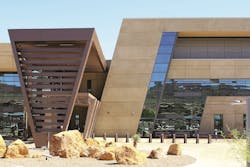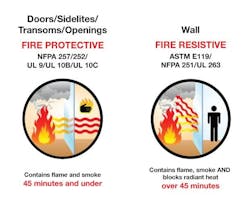How Fire Rated Glass Meets Lot Line Requirements Without Sacrificing Design
Fire rated glass fulfills the designer’s goals of having unobstructed views and natural light. In cities like New York, Chicago, San Francisco or Boston where buildings are typically in close proximity to one another, designers can turn to fire rated glass to meet lot line requirements without sacrificing transparency. When employing this strategy, determining when fire rated requirements apply, the type of fire rated glass allowed (whether its fire protective or fire resistive), or how much fire rated glass can be used are just some of the factors that designers have to consider.
Explaining Lot Line Requirements
The fire resistance rating for exterior walls is based on construction type, occupancy and fire separation distance as defined in Section 6 of the IBC. These fire resistance requirements range from no required rating to 3 hours. Exterior walls generally have a rating based solely on interior occupancy use and structural requirements. However, exterior walls that are 10 feet or less from the property line are required to have a fire resistance rating based on the proximity to adjacent buildings and interior occupancy conditions. The 2009 IBC increased this distance from five to 10 feet.
An exterior wall may or may not be allowed to have openings depending on the fire separation distance. Chapter 2 of the IBC defines fire separation distance as the distance measured from the building face to one of the following:
- The closest interior lot line.
- To the centerline of a street, an alley or public way.
- To an imaginary line between two buildings on the lot.
The distance shall be measured at right angles from the face of the wall.
Once the fire separation distance has been established, Table 705.8 in the IBC lay out the percentage of protected and unprotected openings and size limits allowed in exterior walls. When allowed, the codes distinguish between openings that are “unprotected” (no fire rating) with or without sprinklers, and “protected” (such as fire protective glazing in openings tested to NFPA 257/UL 9):
- UP, NS = Unprotected openings in buildings not equipped throughout with an automatic sprinkler system in accordance with Section 903.3.1.1.
- UP, S = Unprotected openings in buildings equipped throughout with an automatic sprinkler system in accordance with Section 903.3.1.1.
- P = Openings protected with an opening protective assembly in accordance with Section 705.8.2.
Fire protective glass like 45-minute ceramics tested to NFPA 257/UL 9 are either limited in size or prohibited altogether depending on the fire separation distance. Generally speaking, as the fire separation distance increases, the allowable opening area and the percentage of allowable fire protective openings increases.
However, these limitations do not apply to fire resistive glass tested to the more stringent ASTM E-119/UL 263 standard, which requires limiting the temperature rise to less than 250º F above ambient on the non-fire side. Designers can use fire resistive glass in areas where exterior openings are not permitted or limited in size per IBC Table 705.8. By using fire resistive glass, designers don’t have to sacrifice expansive clear views and abundant natural light in order to meet code requirements.
Two types of fire rated glazing recognized in the IBC: Fire Protective Glass vs Fire Resistive Glass as explained in this quick, informative video.
In addition to meeting lot line requirements in the code, these advanced fire resistive glazing systems can perform like the rest of the materials in the building envelope and even match the aesthetic of adjacent non-rated glazing systems.
Dynamic Curtain Wall Testing
Static curtain wall testing performed in a chamber is one way to determine a product’s ability to prevent air and water from entering the building. However, the information from this test is limited. This is why dynamic curtain wall testing designed to duplicate real world conditions is preferred by owners, architects and building envelope consultants.
Today’s advanced fire resistive curtain wall systems are tested to AAMA 501.1, ASTM E284 and ASTM E331. In addition to air and water testing, these systems are also tested to AAMA 501.4, ASTM E330, interstory vertical displacement, thermal cycling and condensation evaluation.
The 1-hour fire resistive curtain wall at The Kensington in Boston successfully passed dynamic curtain wall testing. Architect: The Architectural Team, Inc. Glazier: Cheviot Corporation. Products used: SuperLite II-XL 60 in GPX Curtain Wall. Read the case study here.
Thermal Performance
Occupant comfort is a key factor when selecting glazing products for the building envelope. While glass gives the benefit of natural daylight, controlling heat and glare are important considerations as well. Today’s advanced fire resistive glass products can easily incorporate low-e or any energy performance glazing. Designers can also find both fire protective and resistive glass and framing components in the NFRC CMAST database, enabling them to simulate the U-factor, Solar Heat Gain Coefficient (SHGC) and Visual Light Transmission (VLT) of exterior fire rated glazing assemblies.
The large, 2 hour fire resistive exterior glass walls used on the penthouse of The Warehouse in New York’s Chelsea neighborhood incorporates high-performance glazing to meet the stringent energy requirements. Architect: Morris Adjmi Architects. Glazier: Vision Walls. Products used: SuperLite II-XLB 120 in GPX Architectural Series Framing. Read the case study here.
Multi-tasking Protection Against Other Threats
Advanced fire resistive glazing systems can multi-task to provide additional protection against various environmental and man-made threats. Fire resistive glazing manufacturers have tested and listed systems that also meet:
- Florida Product Approval, Texas Department of Insurance and UL certifications for hurricane;
- Up to UL 752 Level 8 for ballistic;
- US Department of Defense (DOD) Minimum Antiterrorism Standards for blast;
- ASTM F-1915 Grade 1-4 for forced entry.
With the architectural community pushing the limits of what fire rated glass can do, manufacturers will continue to respond with innovative products that fulfill their design and performance needs.



